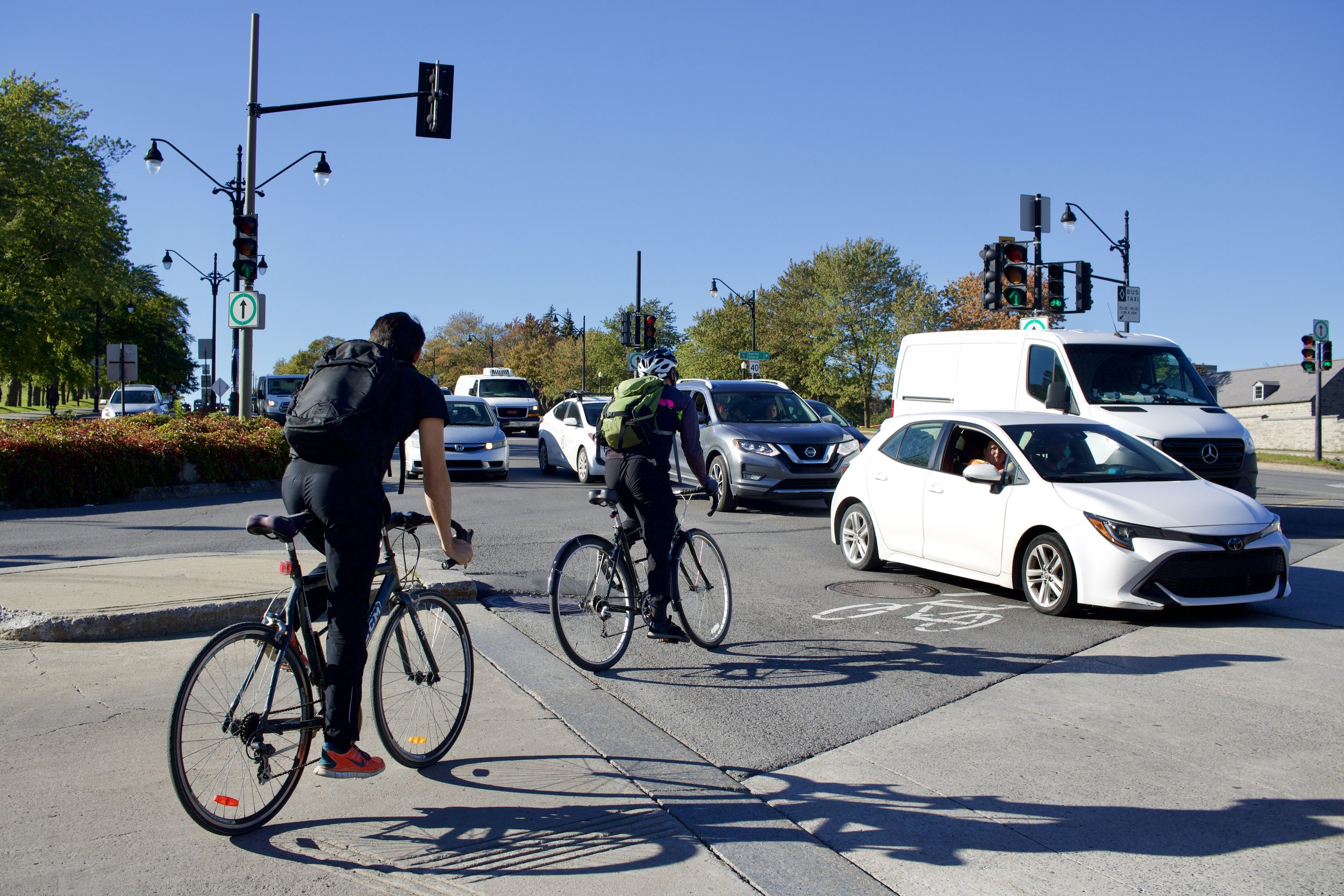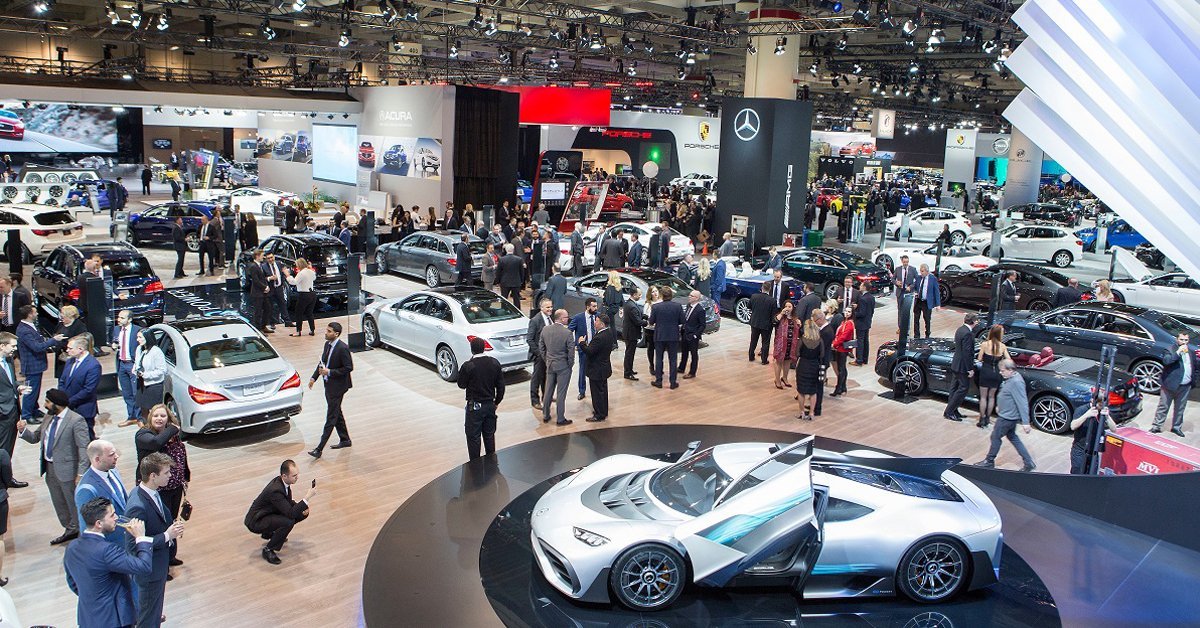How Toxic Masculinity Drives Car Culture
Two people biking through a row of vehicles despite a green light for cyclists (Photo by: Nicole Roach, Montreal, QC, 2022)
Cities across the country are struggling with bumper to bumper traffic, and all of the problems that come with it. In 2020, the transportation sector was the second largest source of GHG emissions, producing 24% of total national emissions. That same year, motor vehicle traffic collisions led to nearly 2,000 fatalities and over 100,000 reported injuries. It’s also estimated that the average Canadian spends between 750 to 800 hours a year in their car and about $8,880 a year on fuel, maintenance, insurance, and additional expenses. In short, our over reliance on cars is harming our environment, our cities, and ourselves.
At a time when it is vital that we as a society wean off personal vehicles, trends are finding that vehicles are getting bigger, heavier, more dangerous, and to boot, we are driving them more frequently. While many Canadians reach for the car keys over a bus pass or citi-bike, studies have shown that men own more cars than women and are twice as likely as women to travel using individual vehicles.
Men driving more than women is part of a long history of men dominating the automotive industry, elevating vehicles over all other modes of transportation, and linking large and fast vehicles to their masculine identities. This has led to some men using vehicles as tools for intimidation, domination, and violence against others, especially towards women and other marginalized groups. Here is an overview of how toxic masculinity fuels car culture and some solutions to help wean men, and all Canadians, off their cars.
Men Made the Cars
The first automobile was invented in the 19th century in Europe, with technological developments coming from men in France, Belgium, and Germany. The early automobiles were considered a luxury, until mechanics in Detroit turned the automobile into the kinds of vehicles we know today - mass-produced, low-priced, and reliably convenient for the average user. Men dominated the industry, with the likes of Henry Ford, Charles and Frank Duryea, Henry Leland, and Walter Chrysler leading mass production of automobiles across North America.
Toronto Auto Show 2019 (photo via Global News Toronto)
Industry
The booming industry in the states began setting up branch plants in Canada, with a large concentration of plants finding a home in Windsor, Ontario, and the surrounding area. By the early 1900’s the Canadian industry had established the “Big Three” manufacturers - General Motors, Ford, and Chrysler - and Canada was the second-largest vehicle producer in the world. While global manufacturing trends and consumer trends have shifted over the decades, the industry has long continued the legacy of being male dominated - from the production line all the way to the executive suites. In 2013, Jeremy Cato published in the Globe and Mail, “Not one single car company in the entire world is run by a woman. Not one.” While this has improved in recent years, women are still dramatically underrepresented in leadership positions. Allyson Bell, General Manager of Hunt Club Volkswagen in Ottawa, expressed challenges in recruiting and retaining young women in the industry, claiming “There is a huge sexist cult in this business”.
Design
With men at the helm of designing, manufacturing, and selling vehicles, it is no wonder that their needs and preferences have been well reflected in the vehicles on our roads. Despite the data showing that men are more likely to engage in risky behaviours behind the wheel, such as speeding, driving under the influence, and driving without a seat belt, women are more likely to be seriously injured if involved in a crash. Studies have found that belted women have 73% greater odds of being hurt in frontal car crashes compared to men wearing seat belts. This is largely attributed to the way that vehicles are tested, using crash test dummies modelled after the average male body. There are very few average female crash test dummy available (some have emerged in recent years), despite women’s bodies reacting differently than men’s when collisions occur. For example, the average American female is 5.4 inches shorter and 27 lbs lighter than the average man, meaning that they often sit closer to the steering wheel, and because of women’s chests, they may also wear seat belts differently than men. As outlined by Caroline Criado-Perez, “we are so used to thinking of the average male as the average human”, and that has been reflected in the design and safety testing of automobiles for decades.
Female increased risk of injury graphic (graphic via NHTSA Injury Vulnerability and Effectiveness of Occupant Protection Technologies for Older Occupants and Women)
Consumers
Many men see their vehicles as an extension of themselves and seek to present a strong image, as explained by Marshall Schuon in the New York Times, “What we (men) want, whether we admit it or not, are rolling advertisements for ourselves, and the chief difficulty is in choosing the right billboard.” This drives many men to choose vehicles that present a strong image, opting for vehicles that demonstrate wealth, power, speed, size, and dominance - both to impress other men and to attract women. This leads to increased consumer demands for sports cars, muscle cars, and large trucks, with light-duty trucks making up 80% of new vehicle sales in Canada in recent years. Understandably, some people require trucks for their work, but this segment of truck drivers likely does not account for the majority of truck owners. The increasing sizes of vehicles on our roads has contributed to Canadians driving some of the most dangerous and most polluting vehicles in the world.
Child standing in front of Ford truck (Photo by Angie Schmitt via CityLab, 2021)
Bringing more gender diversity into the automotive industry likely won’t solve the problems built into the sector, but it may help to make vehicles slower, smaller, and safer going forward.
Men Designed the Cities
Most cities across North America were largely built in the post-war era, with much of the architecture, transportation planning, and urban sprawl being led by men. Once vehicles were introduced, the buildings, the highways, and the sprawled out communities in between were designed to move cars, and bring working men from the suburbs to the downtown cores on a standard 9-5 work schedule.
Reinforcement
While many cities were initially built around the personal automobile, these trends have continued to be reinforced through design and policies. As outlined by self-proclaimed ‘Recovering Engineer’ Charles Marohn, “when it came to designing roads, safety and cost were considered only after prioritizing traffic speeds and volume. This is still standard operating for engineers.” These practices have had traffic engineers chopping down trees, widening roads, and expanding highways to their heart's content - all in the name of traffic volume and speed (induced demand, who?).
Vehicles driving past a gas station (Photo by: Nicole Roach, Winnipeg, MB, 2020)
Resistance
Men have largely shaped the way that everyone moves around cities, and calls to re-allocate vehicle lanes for public transit, active mobility, or public space has often led to public outcry. In Vancouver, the creation of the 1996 Burrard Bridge bike lane led to angry comments from drivers equating the change with a level nine on the “richter scale of disaster.”
Cyclists and pedestrians commuting in the Burrard Bridge cycle lane (Photo via Vancouver Bike Guide)
In Toronto, Premier Doug Ford made a video while stuck in traffic calling the King Street Pilot a disaster, claiming “This is a war on the car. Folks, this has to come to an end,” despite the positive benefits of elevating other transportation modes. Similarly, in Winnipeg, calls for 30 km/hr speed limits were met with loud resistance in the form of a petition. One resident and signee, Werner Hohler, stated “The purpose of this petition is to show our local politicians that we, a group of drivers and other concerned residents, want to keep the status quo.”
Signs showing support for the Love 30 campaign (Photo by: Nicole Roach, Winnipeg, MB, 2020)
Additionally, well-known misogynist, Dr. Jordan B. Peterson, recently weighed in on walkable neighbourhoods, tweeting “The idea that neighbourhoods should be walkable is lovely. The idea that idiot tyrannical bureaucrats can decide by fiat where you’re “allowed” to drive is perhaps the worst imaginable perversion of that idea–and, make no mistake, it’s part of a well-documented plan.”
Through these examples and many more, we see drivers seeking to maintain the dangerous, unhealthy, and unsustainable transportation systems we have in place. They fight so hard, because many of them view a “threat” to their right to drive as a direct threat to their masculine identity.
Men Made Cars Masculine
Major design and testing decisions for vehicles were made to suit men, along with redesigning once walkable, human-scaled cities as places meant to move and store cars en masse. These decisions were motivated by money, power, and of course, upholding the patriarchy. So, how did the car become such a prevalent symbol for masculinity? That was by design, too.
Marketing
Marketing has played an important role in shaping the image of cars, and as a byproduct, shaping the identity of those who drive them. Early video marketing from the automobile industry showcases the Land Rover Defender as a rugged and strong vehicle scaling the side of a hydro dam. Similarly, a Ford Cougar ad featured celebrity Dennis Hopper driving alongside a “wild” version of himself on a motorcycle, complete with the Born to be Wild song playing and the two of them gawking at a waitress.
In 2005, Chevrolet’s Colorado truck was advertised with a group of men in the truck all “shunning” one in the group for singing along to a Shania Twain song. The ad was publicly criticized for inflaming a mix of toxic masculinity, misogyny, and homophobia, with it being summarized as “The newest innovation from Chevy: a truck cabin big enough for you AND your gay panic.”
These kinds of ads, along with generations of male socialization that reinforces traditional ideas of masculinity and discourages traits and actions deemed typically feminine, have had a hand in shaping men as consumers. This creates a vicious cycle for car ownership offering men not just a means of transportation but access to masculine identity and acceptance within the patriarchy.
Subaru GL Coupe advertisement stating “like a spirited woman who yearns to be tamed”. (Graphic via metro.co.uk)
Pop-Culture
This masculine identity has continued to be reinforced through pop culture, with just one example being the $6 billion dollar Fast and Furious franchise. As one of Universal’s most successful film series, these movies both exemplify how macho men, fast cars, and women are viewed as part of car culture, and also reinforces and idealizes these perceptions to viewers. With the rise of social media, car culture is highly visible through influencers, celebrities, and peers. The most topical example is from Andrew Tate - someone who claims women belong in the home, can’t drive, and are a man’s property - who recently attacked young climate activist, Greta Thunberg over Twitter stating “Hello @GretaThunberg I have 33 cars. (...) Please provide your email address so I can send a complete list of my car collection and their respective enormous emissions.” Not only publicly bragging about his collection of luxury vehicles, but boasting about the enormous environmental impacts - all while harassing a 19 year old woman online.
Violence
The hyper-masculine images depicted through ads and pop-culture have also led to vehicles being used as tools of male violence. During the Unite the Right rally in Charlottesville in 2017, Heather Heyer Way was killed by a white supremacist that drove over counter-protestors. This is by no means an isolated incident, with the car being used as a weapon against anti-racist protestors time and time again, as well as being used for extremist terrorist attacks around the world. In Los Angeles, police officers drove their car through a group of protestors, in Brooklyn, a police officer riding in the passenger seat of a patrol vehicle opened their door to intentionally strike a protester as the car drove past them, and many more examples that took place across the United States in 2020.
Drivers plowing into protestors and parked cars on the mall. (Photo by: Jeremiah Knupp via USA Today, Charlottesville, VA, 2017)
Similar events have occurred in Canada as well, with the most clear examples being found in the truck convoys of 2022. A long line of truckers made their way across the country to arrive in the capital city to “protest” pandemic measures, with the “Freedom Convoy’s” leadership being composed of far-right groups that embraced the action as the Canadian version of the January 6 riots. The convoy flooded the city’s downtown core, blocking off streets and honking at all hours of the day and night. Supporters joined in the actions, typically donning large trucks with Canadian flags and many “F*ck Trudeau” bumper stickers. The participants were emboldened, yelling at people wearing masks, stealing food, destroying property, and many other destructive activities.
Trucks and supporters moving down Bloor Street during a demonstration as part of the trucker convoy (Photo by: Nathan Denette via CNN, Ottawa, ON, 2022)
It’s likely unsurprising that men are choosing vehicles and driving based on what they have seen through marketing, pop-culture, and among many of their male peers. This has led to violence ranging from sexist bumper stickers to threatening cat-calls, from blasting music to murdering protestors. All of it must be put to an end.
Putting the Brakes on Male Toxicity and Car Culture
Toxic masculinity isn’t the only thing driving car culture, but it is certainly a factor. It also contributes to street harassment, road rage, traffic violence, and many more behaviours that make our city streets dangerous for everyone.
Addressing toxic masculinity is no easy feat, requiring us to dismantle the patriarchy and other harmful colonial, capitalistic systems of oppression. It can start with holding men accountable for their actions, like calling out sexist comments and harmful behaviours (which is something that other men especially should be doing), and be reinforced through inclusive education, programs, and policies to shift gender norms and expectations.
We must also address the lack of representation in the automotive industry, and in the transportation sector as a whole. Without women and other equity-deserving groups, safety measures and design preferences can be left out, such as female crash test dummies, speed governors, hood visibility, and compact vehicles. Improved designs, such as making vehicles slower, smaller, safer, and more sustainable, should be coupled with stronger regulations for vehicle manufacturing and driving behaviours. These measures can be something like extra costs for large vehicles to park, limits on vehicle lifts in cities, and design regulations that restrict vehicles with little visibility due to their size.
Lastly, we can shift all Canadians away from personal vehicles by making multi-modal transportation more efficient and comfortable, while making driving less convenient. This can include increased gas taxes, commuter fees, parking costs, traffic calming, speed limit reductions, zero-emission zones, and much more.
To solve the pervasive problems in our society and on our streets, we need to tackle both toxic masculinity and car culture. We must recognize that they are interlinked and need to be addressed in tandem for measures to be effective. Men may not fall out of love with their cars anytime soon, but I hope many of them will be willing to at least drive less, drive safer, and to make space for others on our streets.
Let’s make masculinity and our cities a lot less toxic, shall we?
Resources
https://thewalrus.ca/when-cities-are-built-for-white-men/
https://unevenearth.org/2020/10/structural-violence-and-the-automobile/
https://www.printmag.com/advertising/a-brief-history-of-automotive-marketing/
https://www.thecanadianencyclopedia.ca/en/article/automotive-industry
https://canada.autonews.com/leading-women/canadas-auto-industry-still-males-it
https://usa.streetsblog.org/2020/02/27/streetsblog-101-car-culture-is-a-toxic-masculinity-problem/
https://www.npr.org/2020/06/21/880963592/vehicle-attacks-rise-as-extremists-target-protesters
https://www.bloomberg.com/news/articles/2021-03-11/the-dangerous-rise-of-the-supersized-pickup-truck
Edited by: Holly Hixson











